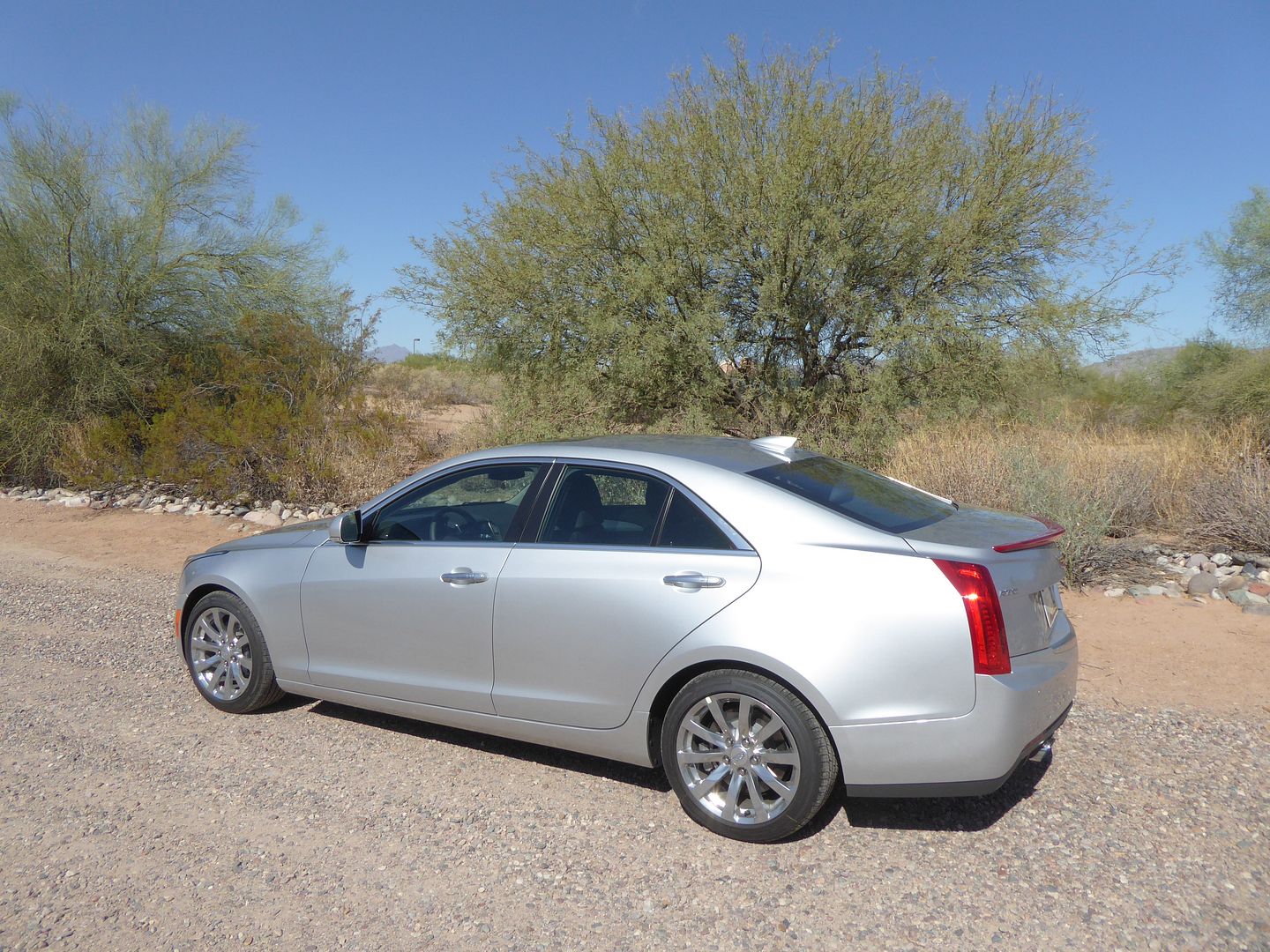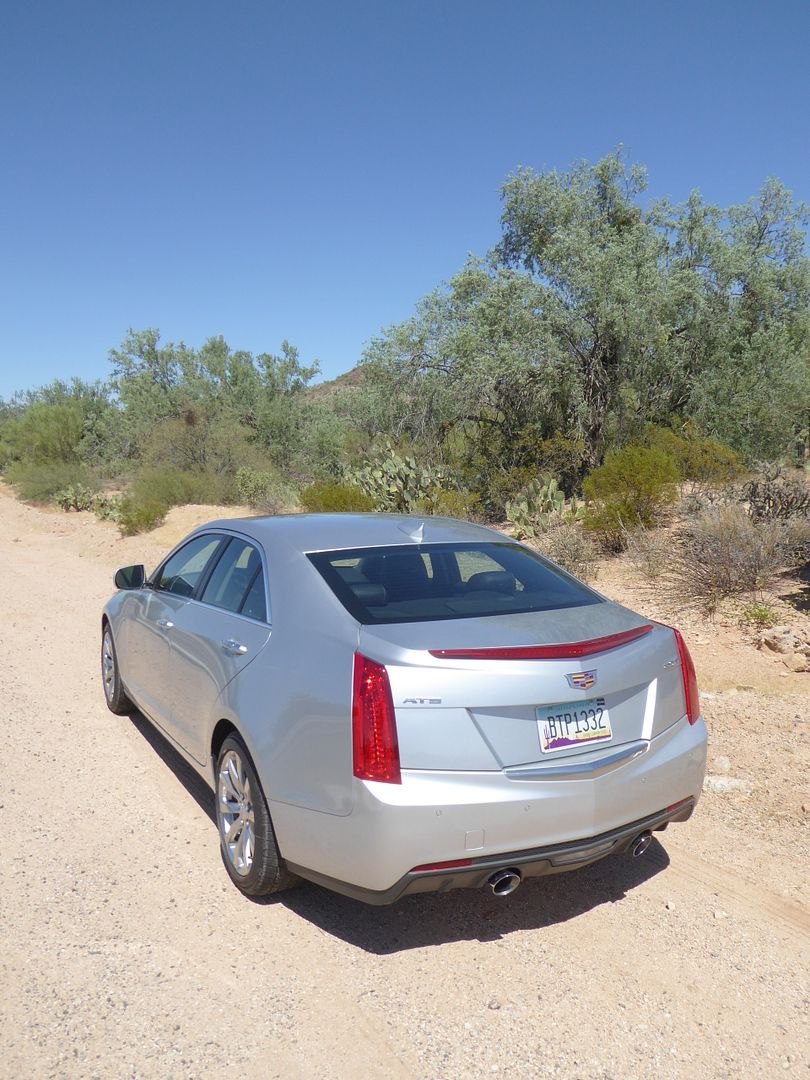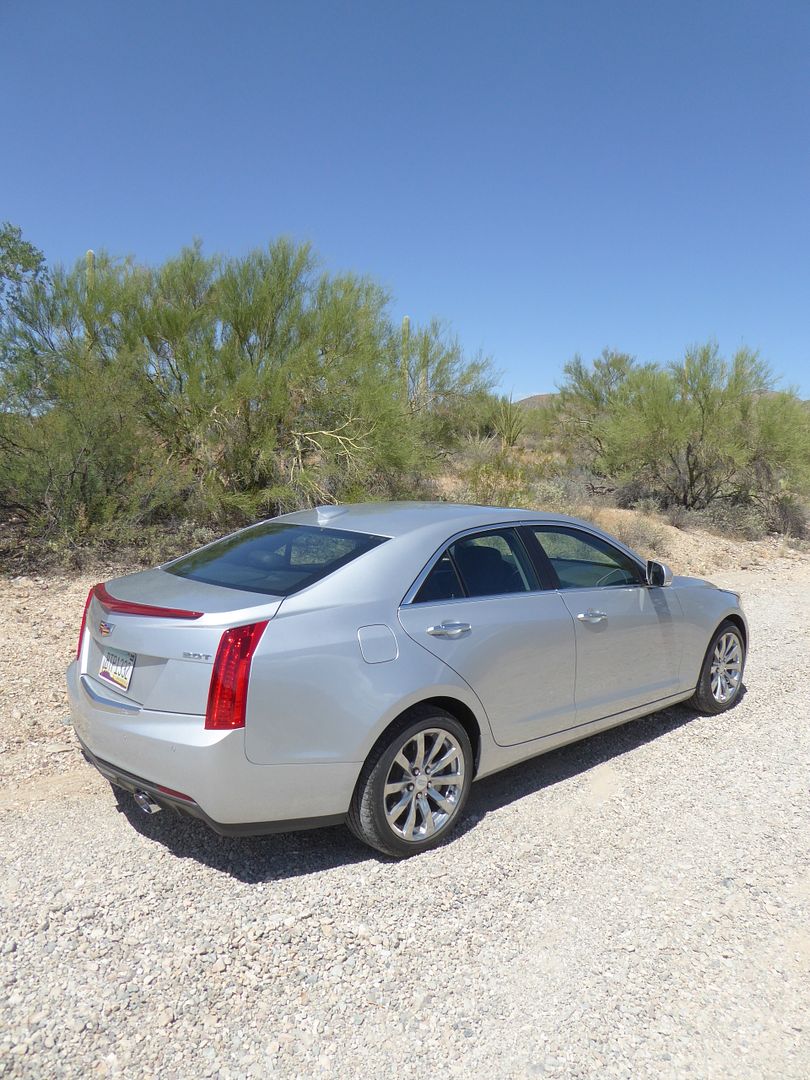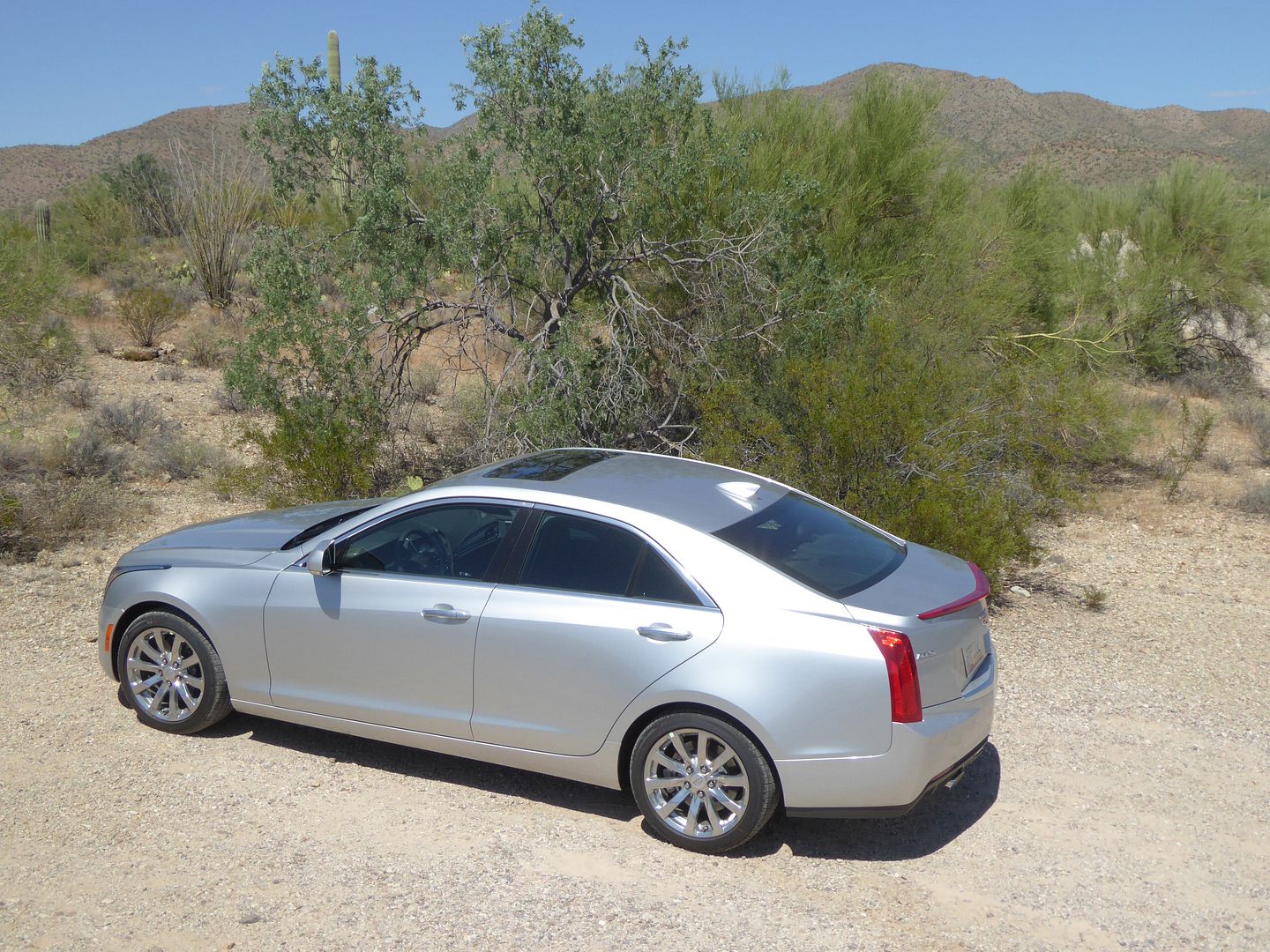









































Cadillac concluded that building the ATS on a cut-down version of the platform that underpinned the second generation CTS was not the right answer, as this would be too heavy, and so they built a new one, the Alpha Platform, which also sees service in the second generation Camaro. This means rear wheel drive, which was clearly something that seemed important if the cars you are going to compete with are also (mostly) configured that way, and it made the offer of an all-wheel drive model – something that is important for the snow-belt States, easy to engineer, and the target of close to 50/50 weight distribution was achieved. There was a strong family resemblance in the styling to the larger CTS, again, something which is a feature of the German rivals, whose products can be hard to tell apart at a quick glance. Certainly, in the early days the ATS and CTS looked very similar, though when the latter was updated in 2014, its new styling was more clearly differentiated from its smaller brother. The initial reviews of the ATS were very positive The US press loved it, and went into that sort of journalistic hyperbole about how this was the car that finally beat the Germans at their own game. Always sceptical of such articles, which seem to be a combination of a quest for attention-grabbing headlines and misplaced nationalistic short-sightedness, I clearly wanted to try the car for myself. Hertz did have some on fleet within a few months of the late 2012 on-sale date, but they never seemed to be available, and then they all vanished. On arriving in Phoenix, though, I noted that there were quite a few brand new cars parked up, and these turned out to be 2018 model year cars. I was able to secure one, at no extra cost from my reservation for a humble mid-sized car, thanks to the new Ultimate Choice program. It had covered just over 500 miles in the week it had been on fleet, and still had that distinctive new car smell to it.
There’s a choice of engines in the ATS. The entry level unit is a 2 litre turbo, developing 272 bhp, and this was the one fitted to the test car. It turned out to be one of the ATS’ stronger points. Although never going to win many prizes for its soundtrack, it proved very willing, smooth and refined, endowing the Cadillac with impressive levels of acceleration from any speed. Coupled to an 8 speed automatic, which made completely seamless gearchanges, the ATS could gather momentum very rapidly, and then hold a freeway cruise at low revs and hence low levels of noise. The engine only sounded coarse if you really revved it hard, but frankly, you would be unlikely to do that very often, as there is sufficient torque to mean that an early-ish gearchange will still give you the acceleration you need. I was slightly surprised to find that the test car had a Stop/Start system in it, and that it was switched on – clearly Cadillac have been studying the Europeans! The ATS consumed 9.25 gallons over a test distance of 257 miles, which computes to a very respectable 27.78 mpg US or 33.19 mpg Imperial.
Cadillac presented the ATS as a European-style sports sedan, claiming that it would drive like a 3 Series or an A4. They are not far off the truth here. It probably is not going to be as good if you were to take it to the track, but on ordinary roads, it acquitted itself pretty well. The steering is well judged. There is plenty of feel, and the weighting is about right. The car corners neatly, with no body roll and not much in the way of understeer, and it rides well on Arizona’s smooth roads. It stops well, too. The foot operated parking brake does perhaps betray its American, as opposed to European origins. Truly this is an American car that is good to drive, with quite a sporty feel to it, but without expecting the driver and passengers to trade that off with compromises in comfort. It scores less well for visibility. Biggest culprit are the door mirrors, which are small, and have too limited a field of view, meaning that there was a huge blind spot which you needed to remember on the freeways. A rear-view camera was useful, as the steeply sloping rear screen meant you could not tell where the back of the car was, although the stubby tail did mean that there was typically more clearance than you thought.
There are two schools of thought on the interior style of the modern Cadillac. The US press have generally gushed with praise on how “upscale” they are, whereas my view (and I am far from alone in thinking this) is that the combination of a vast number of materials, textures and colours, with lots of pale-coloured shiny plastic pretending to be wood is just a bit tawdry. Thankfully, the one in the ATS was much better than this. Indeed, at a glance, it looked like it really was conceived along similar lines to the cars that it competes against. The interior trim of my car was black, and that meant that the dashboard and door casings were all black, with plenty of stitched leather trim on the larger surfaces along with decent looking, and feeling plastics, all of which does lift the quality levels somewhat. There are metal highlight rings which work well in providing some colour contrast. Gloss black inlays featured around the central display screen and in swathes on the steering wheel. As well as presenting the photographers with challenges from the reflections and light patches that showed in them, the real issue was just how quickly fingermarks appeared on any of these areas that were touched. And around the screen, which I will come to, you do touch things quite a lot (unless you want to use the voice recognition, but that’s another chapter of problems!). The main instruments are all digital, so when you get in the car, there is a black panel, which first says “Cadillac” as you press the keyless Start button to fire the ignition. As well as the expected dials for speedo and rev counter and gauges for fuel level and water temperature, there are three data display areas across the bottom, one of which contains the odometer. The others contain what you want them to show from various menus, which you select using some of the buttons on the right hand steering wheel spoke. You can also change the radio channel this way, even if you did not want to. The dials were easy to read with very crisp graphics. That steering wheel did look a bit overloaded with buttons, as the cruise control is also there. Column stalks are clearly from the GM parts bin, and they are the ones with the serrated surface near their ends. The centre of the dash contains the touch sensitive colour display screen for the CUE system, sitting between two vertically stacked air vents. Although CUE is a bit better than it was, I still found it frustrating. You have to use it for many of the functions that previously would have been the simple press of a button, so switching from say FM to Satellite XM radio required you to press one button to change waveband, then to scroll through the list to find the one you wanted, by repeatedly pressing the forward button. The system was sometimes slow to respond, and at times, when I pressed the “home” button, it simply did nothing at all. The whole unit also felt a bit loose in the car, even though it was firmly attached and did not rattle or anything. Under it are a series of touchpads for the dual zone climate control system. Whilst the overall effect is to make the interior look a bit simpler and less button laden, it is clear that Cadillac still have some way to go to meet the standards of usability set by the German rivals.
There were no issues in getting comfortable. The seats are electrically adjusted, with a series of buttons on the seat side, and there are two memory settings on the door, to allow you to store your chosen position once you’ve found it. Steering column adjustment was manual, with a rather stiff lever buried to the left hand side of the column, but with the wheel telescoping in/out as well as up/down, I could easily get things set up the way I wanted them. The seats were trimmed with a nice soft leather, and proved comfortable, something I appreciated when sat on them for far longer than anticipated thanks to a long delay on the I10 freeway following an accident. My only complaint concerns the seat belts. There is no height adjuster to their mounting, and they were set far too low for me. This seemed a surprising omission especially, when I found the feature on the bargain-basement Kia Rio that I would be driving the following day.
Those in the back of the ATS may not be quite so content. Space here is a bit tight. Set the front seats well back, and leg and knee room is limited. Whilst there is probably ample width across the seat for three occupants, there is a fairly sizeable transmission tunnel, and the central console unit protrudes well back, so the middle seat passenger would have to sit with their legs astride this. Headroom proved adequate, despite the slightly sloping rear roofline. There is a drop down armrest which has two cupholders and a lidded cubby on its upper surface. Occupants here also get bins on the doors and map pockets in the seat backs, for their odds and ends. There are air vents in the rear face of that central cubby unit.
As you might expect from the short tail, the boot is not massive, being somewhat smaller than that of its main rivals. It is surprisingly long from front to back, but is quite shallow and the floor is not completely flat across the width of the car, though, with raised areas at either side. There are stowage wells at the very side, and there is space under the floor around the spacesaver for a few bits and pieces. The rear seat backrests can be folded forward for extra load length and there is also a ski flap through the central armrest. Up front, there is a reasonable sized glovebox, bins on the doors, and a cubby under the central armrest. I was a little surprised to see that the two cupholders in the central console did not have a sliding cover, something I would rather have expected to see.
Although the ATS range is nothing like as extensive as those of the dread German rivals, there are plenty of versions to choose from. There are also two body styles: a four door saloon as tested here and a 2 door coupe. There are ATS-V versions of both with thunderous 464 bhp twin turbo 3.6 litre V6 engines, and a range of other mechanical enhancements aimed at rivalling the M3/4, C63 AMGs and the RS5 Audi. Lower down, you get a choice of two engines: the 2 litre turbo as tested here or a 335 bhp 3.6 litre V6. The previous entry level 2,5 litre unit was deleted at the end of 2016. There is a further choice of rear or all-wheel drive. And then there are trim levels. Start point is the base Cadillac ATS, which has the 2 litre turbo, an eight-speed automatic transmission, and rear-wheel drive. Sedan models start at $34,595, and coupe models begin at $37,595. A six-speed manual transmission is a no-cost option. All-wheel drive is available for an extra $2,000 ($2,400 in coupe models). Standard equipment includes an 8″ touch screen, Cadillac’s CUE infotainment system (supporting Apple CarPlay and Android Auto), a rearview camera, Teen Driver assist, Bluetooth, three USB ports, XM satellite radio, a Bose sound system, a Wi-Fi hot spot, OnStar telematics, dual-zone climate control, proximity keyless entry, cruise control, power windows, heated side mirrors, and leatherette upholstery. The ATS Luxury trim adds satellite navigation, front and rear parking sensors, leather upholstery, heated front seats, and a heated steering wheel. Sedan models start at $38,395, and coupe models begin at $41,395. A six-speed manual transmission and all-wheel drive are available. Options include a Safety and Security package, which adds forward collision warning, lane keep assist, lane departure warning, blind spot monitoring, rear cross traffic alert, and rain-sensing wipers. It costs $1,850 in sedan models and $1,500 in coupes. The ATS Premium Luxury trim includes the 3.6-litre 335 bhp V6, an eight-speed automatic transmission, and rear-wheel drive. All-wheel drive is optional, though a manual transmission is not. Sedan prices start at $43,995 and coupes at $46,995. Standard equipment includes forward collision warning, lane keep assist, lane departure warning, blind spot monitoring, rear cross traffic alert, rain-sensing wipers, automatic on/off high beam headlights, and a sunroof. Options include a Driver Assist package ($2,150 sedan; $1,900 coupe), which adds adaptive cruise control, front and rear automatic emergency braking, and a head-up display. The ATS Premium Performance trim adds the Magnetic Ride Control adaptive suspension, a limited-slip rear differential, and a head-up display. Only the eight-speed automatic and rear-wheel drive are offered. Sedans are priced at $46,995 and coupes at $49,495. The Driver Assist package is still optional, but at a lower $1,300. At the top of the range is the Cadillac ATS-V, which packs a twin-turbocharged 3.6-litre V6 which puts out 464 bhp, a six-speed manual transmission, and rear-wheel drive. The eight-speed automatic is a $2,000 option. Sedan prices start at $60,695 and coupes at $62,895. Standard equipment includes a tuned Magnetic Ride Control suspension, active noise cancellation, high-performance brakes, a quad exhaust, and an uprated engine cooling system. Notably, a number of features are not standard in this trim. Surprisingly, satellite navigation ($1,350) as well as the Safety and Security package ($1,850 sedan; $1,500 coupe) are options.
I’ve not seen any recent US press comparison tests which suggest that the ATS is the class leader that they declared at its launch. And if you look at the monthly sales numbers, it is pretty clear that the buying public don’t think it is, either. Sales of the ATS are even lower than those of the larger CTS, and are a fraction of those achieved by its German rivals, even in patriotic America, and they’ve been falling every year since launch. And that is probably right. It is not that the ATS is a bad car, as definitely it isn’t. I quite enjoyed my time with it. But the problem is that the A4 and 3 Series are just that bit more polished. They don’t have display screens that feel wobbly, and they don’t have that wretched CUE system. They drive just that bit better, and they’ve got a bit more space in them. So, the best reason I could think of for buying an ATS is because you simply want something different, something that is not a German car. Of course, there are other models that fit that brief, too: the Jaguar XE and Alfa Giulia, as well as the Infiniti Q50 and Lexus IS and Volvo’s S60. To a European, that means the ATS stands little chance, but in America, it can probably win over some people based on the value for money it offers. Given that the CTS was promoted at one stage as a 5 Series-sized car for 3 Series money, then it looks like the same sort of strategy could apply here. Not perhaps one which is going to maximise the profit margins, but one which will sell some cars. Just not as many as Cadillac probably hoped.
































































































